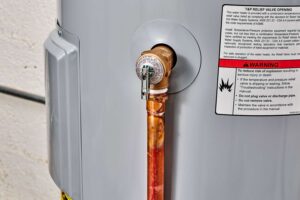To detect hidden plumbing leaks easily, start by checking your water meter for any unusual readings after turning off all water sources and waiting without water usage. Inspect visible pipes for signs of water damage like stains, corrosion, or pooling water. Consider using leak detection devices for pinpoint accuracy, conduct dye tests by adding colored dye to identify leaks, and monitor water usage closely for any deviations. Keep an eye out for water damage signs like stains, peeling paint, or musty odors. If issues persist, seek professional help for thorough inspections and long-term solutions. Remember, taking these simple steps can help you catch leaks early and prevent further damage in your home.
Key Takeaways
- Check water meter for abnormal readings after turning off all water sources.
- Inspect visible pipes for water stains, corrosion, and pooling water.
- Use leak detection devices like electronic detectors and thermal cameras.
- Conduct dye tests by using colored dye in toilets and faucets.
- Monitor water usage, review bills, and install smart monitoring systems.
Checking Water Meter
To determine if you have a hidden plumbing leak, start by examining your water meter for any abnormalities. Begin by ensuring that all water sources in your home are turned off. Take note of the current measurement on the water meter and wait for a few hours without using any water. Revisit the meter and check if the measurement has changed. If the meter shows an increase, it suggests that water is flowing somewhere, indicating a potential hidden leak.
Sometimes, leaks can be elusive and challenging to detect visually. By using the water meter as a tool, you can uncover leaks that might otherwise go unnoticed. If the meter reading continues to rise even after confirming that all water sources are off, it's important to investigate further. This method provides a simple yet effective way to identify hidden plumbing leaks early on, preventing potential damage and saving you from expensive repairs down the line.
Inspecting Visible Pipes
If you suspect a hidden plumbing leak after checking your water meter, the next step is to inspect visible pipes for any signs of water damage or dripping. Start by visually examining all exposed pipes in areas such as basements, crawl spaces, and under sinks. Look for any of the following signs that may indicate a leak:
- Water Stains: Check for discoloration or watermarks along the length of the pipes, which could be a sign of a slow leak.
- Corrosion: Look for any green or white buildup on the pipes, as this could indicate a leak or potential pipe deterioration.
- Pooling Water: Inspect the area around the pipes for any puddles or pooling water, as this suggests an active leak.
- Dripping Sounds: Listen for any dripping or running water noises, especially in quiet environments, which could indicate a hidden leak.
Using Leak Detection Devices
Consider utilizing leak detection devices to pinpoint hidden plumbing leaks quickly and accurately. These tools can help you identify leaks behind walls, under floors, or in other hard-to-reach areas without causing major damage. One common device is an electronic leak detector, which uses sound amplification to detect the sound of water escaping the pipes. By moving the detector along the suspected area, you can narrow down the location of the leak based on the intensity of the sound.
Another useful tool is a thermal imaging camera, which can detect temperature changes caused by water leaks. The camera picks up these temperature variations, allowing you to identify the exact spot where the leak is occurring. Additionally, moisture meters can measure the moisture content in different materials, helping you confirm the presence of a leak and determine its extent.
Conducting Dye Test
Using a colored dye can help you conduct a simple and effective test to detect hidden plumbing leaks. Start by adding a few drops of food coloring into the toilet tank and wait without flushing. After about 30 minutes, check the toilet bowl; if the water is colored, it indicates a leak between the tank and the bowl. This method is also applicable to detect leaks in faucets and pipes, providing a visual cue to identify the source of the problem easily.
- Toilet Tank Test: Add food coloring to the toilet tank and observe if the water in the bowl changes color without flushing.
- Faucet Test: Apply dye to the faucet head and check for any colored water dripping from the faucet.
- Pipe Inspection: Pour dye down the suspected pipe and see if any colored water appears where it shouldn't.
- Simple and Cost-Effective: Dye tests are affordable and can be done at home without professional assistance.
Monitoring Water Usage
To effectively monitor water usage in your home, keep track of your daily consumption and be mindful of any unexpected spikes. Start by checking your water meter regularly. Take note of the readings at the same time each day to establish a baseline. Any significant deviation from this baseline could indicate a potential leak.
Another way to monitor water usage is by reviewing your water bills. Compare your current usage to previous months. A sudden increase in your bill without a corresponding increase in usage habits may point to a hidden leak.
Additionally, consider installing a smart water monitoring system. These devices can provide real-time data on your water consumption and alert you to any unusual activity. By staying informed about your water usage patterns, you can quickly detect any abnormalities and address them promptly, potentially saving both water and money in the long run.
Being proactive in monitoring your water usage can help you identify hidden plumbing leaks early on, preventing further damage to your home.
Examining Water Damage Signs
Inspect your walls and ceilings for any visible stains, bulging, or peeling paint as potential signs of water damage. These areas can indicate underlying leaks that need immediate attention. Additionally, check for musty odors or mold growth, as these are also common indicators of water infiltration. Here are some key signs to look out for:
- Stains: Keep an eye out for discolored patches on walls or ceilings, which may vary in color from yellowish-brown to dark brown, indicating water seepage.
- Bulging: Any unexplained bulging or warping of walls or ceilings could be a sign of water accumulating behind the surfaces.
- Peeling Paint: Paint that is peeling or blistering can suggest excess moisture, possibly due to hidden leaks within the structure.
- Sagging Floors: If you notice floors starting to sag or buckle, it could be a result of prolonged water exposure, requiring immediate investigation and repair.
Seeking Professional Help
If you encounter persistent water damage signs despite your efforts to address them, consider reaching out to a qualified professional to accurately identify and repair any hidden plumbing leaks. Professional plumbers have the expertise and tools necessary to detect leaks behind walls, under floors, or within the foundation of your home. They can conduct thorough inspections using specialized equipment like leak detectors, infrared cameras, and moisture meters to pinpoint the exact location of the leak without causing unnecessary damage to your property.
Moreover, hiring a professional guarantees that the underlying issue causing the leak is properly addressed. Professionals can provide long-term solutions to prevent future leaks, potentially saving you from costly repairs in the future. Additionally, they can offer advice on maintenance practices to keep your plumbing system in good condition and prevent leaks from occurring again.
Don't hesitate to seek professional help if you suspect hidden plumbing leaks that are causing water damage in your home. By entrusting the job to a skilled professional, you can make certain that the issue is resolved efficiently and effectively.
Conclusion
Masterflo Plumbing is North Georgia's most trusted plumbing company. With over 20 years of experience and staffed with master plumbers, our team is equipped and ready to serve your plumbing needs. Whether you need water heater repair or replacement, or have minor or major plumbing problems, you can count on Masterflo Plumbing to handle all your plumbing needs in Cherokee County and metro Atlanta.

